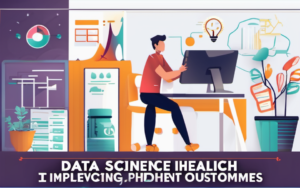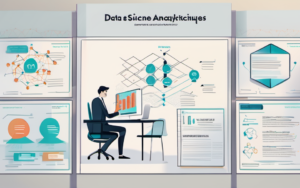The world of data has come a long way, from the rudimentary days of spreadsheets to the sophisticated realm of data science. Today, data is a powerful resource, driving innovation and shaping decisions across diverse industries. But how did we get here? This journey, from simple data manipulation to complex data analysis, is fascinating and reveals a transformative evolution in the way we interact with and extract insights from data.
From Spreadsheets to Data Science: A Journey Through Time
The Humble Spreadsheet: A Foundation for Data Analysis
The spreadsheet, a simple yet powerful tool, laid the foundation for data analysis. It provided a structured way to organize, manipulate, and visualize data. From tracking personal finances to managing inventory in businesses, spreadsheets became ubiquitous, empowering individuals and organizations to make data-driven decisions. While basic, spreadsheets allowed users to perform calculations, sort data, and create simple charts, laying the groundwork for more advanced analytical techniques.
The Rise of Data Science: A Paradigm Shift
However, the limitations of spreadsheets soon became apparent. As data volumes grew and analytical needs became more complex, a new paradigm emerged – data science. This revolutionary field brought together diverse disciplines like statistics, computer science, and domain expertise to unlock the hidden potential of data. Data science offered powerful tools and techniques for analyzing vast datasets, identifying patterns, and building predictive models, paving the way for data-driven insights and innovations.
The Evolution of Data Analysis Tools
Spreadsheets: The Early Days of Data Manipulation
The early days of data analysis were dominated by spreadsheets like Microsoft Excel and Lotus 1-2-3. These tools provided a user-friendly interface for basic data manipulation, allowing users to perform calculations, create charts, and even perform rudimentary statistical analysis. Though limited in scope, spreadsheets laid the groundwork for data analysis, empowering individuals to understand and interpret data.
Statistical Software: Empowering Data Exploration
As data analysis needs evolved, dedicated statistical software emerged, offering more advanced capabilities. Packages like SPSS and SAS provided powerful statistical tools for hypothesis testing, regression analysis, and data visualization. These software solutions empowered researchers and analysts to explore data in greater detail, uncovering insights that were previously impossible to obtain with spreadsheets.
Data Science Languages: Unlocking Advanced Analytics
The rise of data science ushered in a new era of data analysis, marked by the emergence of powerful programming languages like Python and R. These languages provided the flexibility and power to handle massive datasets, develop complex algorithms, and build sophisticated predictive models. Python, in particular, gained immense popularity due to its extensive libraries for data manipulation, analysis, and visualization, making it a versatile tool for both data scientists and programmers.
Key Skills for Data Science Success
Programming Proficiency: The Language of Data
A solid foundation in programming is essential for data science, as it enables you to manipulate data, build models, and automate tasks. Python, R, and SQL are popular choices for data scientists, providing powerful tools for data cleaning, analysis, and machine learning. Programming proficiency allows you to efficiently handle large datasets, develop custom algorithms, and create innovative solutions.
Statistical Foundations: Understanding Data Patterns
Understanding statistical concepts is crucial for interpreting data and drawing meaningful conclusions. Data scientists need to be proficient in probability, hypothesis testing, regression analysis, and other statistical techniques to identify patterns, analyze trends, and make informed decisions. A strong statistical foundation enables you to design experiments, analyze data effectively, and build robust models.
Machine Learning: Building Predictive Models
Machine learning, a subset of artificial intelligence, plays a pivotal role in data science. By enabling computers to learn from data without explicit programming, machine learning allows us to build predictive models that can analyze vast datasets, identify patterns, and make informed predictions. This technology empowers us to solve complex problems, optimize processes, and make data-driven decisions.
The Future of Data Science: A World of Possibilities
Artificial Intelligence: Transforming Industries
Data science is at the forefront of the AI revolution, enabling the development of intelligent systems that can learn, reason, and act autonomously. AI applications are transforming industries, from healthcare and finance to transportation and manufacturing, driving efficiency, improving decision-making, and creating new possibilities.
Big Data Analytics: Unlocking Insights from Massive Datasets
The volume of data generated worldwide is exploding, creating an unprecedented opportunity to unlock insights from massive datasets. Big data analytics, powered by data science, enables us to analyze this data, identify trends, and uncover patterns that were previously hidden. This technology is transforming industries, driving innovation, and shaping the future.
Data-Driven Decision Making: Shaping the Future
Data science is empowering organizations to make informed decisions based on real-world data. By analyzing data, identifying patterns, and building predictive models, organizations can optimize their operations, improve customer experience, and gain a competitive advantage. Data-driven decision-making is shaping the future, driving innovation and transforming the way we live, work, and interact with the world.
The journey from spreadsheets to data science has been remarkable, fueled by technological advancements and a growing understanding of the power of data. As we move forward, the future of data science holds immense promise, with AI, big data analytics, and data-driven decision-making shaping the world around us.




